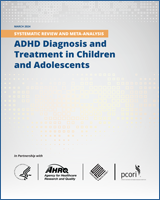From: 2, Methods

NCBI Bookshelf. A service of the National Library of Medicine, National Institutes of Health.
| PICOTSO Element | KQ1 (Diagnosis) | KQ2 (Treatments) | KQ3 (Monitoring) |
|---|---|---|---|
| Population |
Individuals birth through 17 years of age without the diagnosis of ADHD Exclusion: Individuals 18 years of age or older unless findings are reported separately for younger participants |
Individuals birth through 17 years of age with a diagnosis of ADHD Exclusion: Individuals 18 years of age or older unless findings are reported separately for younger participants |
Individuals birth through 17 years of age who have previously begun treatment for ADHD Exclusion: For long-term studies, the age of the individuals were greater than 17, but these studies were only considered for inclusion if the age at enrollment in the study was 18 years or younger, and administrative claims data used for diagnosis of ADHD |
| Interventions |
Any ADHD diagnostic strategy for the diagnosis of ADHD in children through 17 years Exclusion: Validation studies or not reporting on diagnostic performance; non-English language questionnaires and interview guides |
Any treatment of ADHD, alone or in combination. Exclusion: Studies with less than 4 weeks of treatment | Follow-up visit methods and frequencies for monitoring, independent of treatment, including remote monitoring or telehealth strategies |
| Comparators |
Confirmation of diagnosis by a specialist (gold standard), such as a psychologist, psychiatrist or other care provider using a well-validated and reliable process of confirming a clinical diagnosis of ADHD Exclusion: Comparison to diagnosis with a non-validated instrument |
Specific treatments compared with other treatments as described above or to no treatment Exclusion: Comparisons to other patient groups rather than treatments | Follow-up compared with differing frequencies of follow-up or different settings of follow-up for monitoring strategies; no restrictions for long-term outcomes |
| Outcomes | Diagnostic accuracy (e.g., sensitivity, specificity, accuracy, area under the curve, positive predictive value, negative predictive value, likelihood ratios, false positives, false negatives, false negatives, false positives, misdiagnosis, stigma, and costs following diagnosis comparing those with and without ADHD | Patient health outcomes, global clinical impression, social and family functioning, functional impairment, executive functioning, academic performance outcomes, acceptability of treatment, adverse events of treatment, loss of spontaneity, progress toward patient-identified goals, quality of peer relationships, motor vehicle collisions or other accidents, risk-taking behaviors and interactions with the legal system | Monitoring strategy success (e.g., feasibility, uptake), changes in treatment or dose, adverse effects of treatment, changes in intermediate and final outcomes |
| Timing |
| Any | Any |
| Setting | Primary or specialty care settings | Any (including remote monitoring and telehealth) | Any (including remote monitoring and telehealth) |
| Study Design |
|
|
|
| Other limiters |
|
|
|
From: 2, Methods

NCBI Bookshelf. A service of the National Library of Medicine, National Institutes of Health.